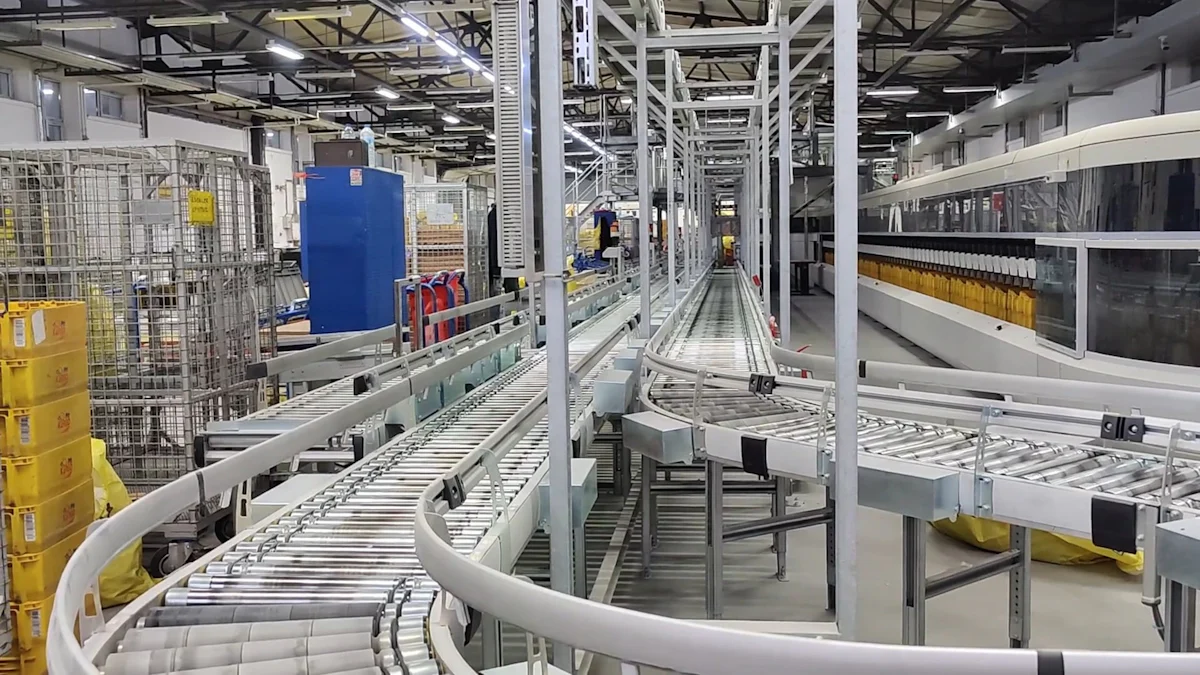How to Use Business Automation to Streamline Workflows

Business Automation transforms how you manage tasks, allowing you to focus on growth rather than mundane operations. By streamlining workflows, you enhance efficiency and productivity. Imagine saving up to 360 hours annually by automating repetitive tasks. This isn't just a dream; it's a reality for many organizations. Over 50% of business leaders plan to increase automation, recognizing its potential to boost productivity. However, challenges persist. Balancing efficiency with innovation and managing complex processes can be daunting. Yet, with the right methodology, such as integrating Hiring Systems and optimizing Sales processes, you can overcome these hurdles.
Identifying the Problem: Pressure on Business Leaders
Business leaders face immense pressure in today's fast-paced environment. You must navigate through a maze of challenges to keep your organization competitive and efficient. Understanding these challenges is crucial to finding effective solutions.
Increasing Complexity in Business Operations
Modern businesses operate in a complex landscape. You often juggle multiple processes simultaneously, which can become overwhelming.
Managing Multiple Processes
Managing various processes requires your attention to detail and coordination. Each process demands specific resources and time, making it difficult to maintain consistency. Manual processes can slow you down, leading to inefficiencies. In contrast, automated processes streamline tasks, allowing you to focus on strategic goals.
Balancing Efficiency and Innovation
Balancing efficiency with innovation is another challenge. You strive to improve productivity while fostering creativity. This balance is essential for growth but can be difficult to achieve. Automation offers a methodology to enhance efficiency without stifling innovation. By automating routine tasks, you free up time for creative endeavors.
The Need for Improved Productivity
Productivity is a key driver of success. You need to optimize your resources to achieve better outcomes.
Time Constraints
Time constraints are a common issue. You have limited hours to complete tasks, which can lead to stress and burnout. Automation helps you manage time effectively by reducing manual work. This allows you to allocate more time to high-priority projects.
Resource Allocation Challenges
Resource allocation is another hurdle. You must ensure that resources are used efficiently to maximize output. Automated systems provide a methodology for better resource management. By automating repetitive tasks, you can allocate resources more strategically, improving overall productivity.
"Some processes are better suited for automation than others." This insight highlights the importance of choosing the right processes to automate. By identifying areas where automation can have the most impact, you can significantly enhance your workflow.
Presenting the Solution: Business Automation
Business Automation offers a transformative solution to the challenges you face in managing workflows. By leveraging technology, you can automate repetitive tasks, allowing your team to focus on strategic initiatives. This approach not only enhances efficiency but also improves accuracy and productivity.
What is Business Automation?
Definition and Key Concepts
Business Automation, also known as Business Process Automation, involves using technology to execute recurring tasks or processes. Instead of relying on manual effort, you can optimize workflows to achieve greater efficiency. This means your team can concentrate on tasks that require human creativity and decision-making.
Types of Business Automation Tools
Various tools are available to help you implement Business Automation. These tools, often referred to as workflow automation tools, enable you to automate key business processes from start to finish. They offer a wide range of automations, making them versatile for different business needs. By integrating these tools, you can streamline operations and reduce the likelihood of human error.
How Automation Streamlines Workflows
Reducing Manual Tasks
Automation significantly reduces the need for manual intervention in routine tasks. By automating these processes, you save time and minimize errors. This allows your employees to focus on more valuable and strategic work, enhancing overall productivity.
Enhancing Process Efficiency
With Business Automation, you can standardize the flow of tasks, information, and documents across various functions. This standardization ensures that processes run smoothly and efficiently, according to predefined business rules. As a result, your organization experiences improved productivity and a more streamlined workflow.
"Automation is about optimizing your workflow to get stuff done more efficiently and accurately." This insight emphasizes the importance of adopting Business Automation to enhance your operations.
By embracing Business Automation, you position your organization for success in a competitive landscape. If you're interested in learning more about how to implement these systems effectively, reach out to us for guidance.
Benefits of Business Automation

Increased Efficiency and Productivity
Business automation significantly boosts your efficiency and productivity. By automating tasks, you can complete them faster and with greater precision.
Faster Task Completion
Automation allows you to finish tasks more quickly. You no longer need to spend countless hours on repetitive activities. Instead, automated systems handle these tasks swiftly, freeing up your time for more strategic endeavors. This efficiency not only accelerates task completion but also enhances your ability to meet deadlines consistently.
Improved Accuracy
Manual processes often lead to errors and inconsistencies. Automation eliminates these inaccuracies by standardizing operations. Automated systems execute tasks with precision, reducing the likelihood of mistakes. This improved accuracy ensures that your business processes run smoothly, enhancing overall productivity.
"Automation is about optimizing your workflow to get stuff done more efficiently and accurately." This insight emphasizes the importance of adopting Business Automation to enhance your operations.
Cost Savings
Implementing business automation can lead to substantial cost savings. By reducing labor costs and minimizing errors, you can allocate resources more effectively.
Reduction in Labor Costs
Automation reduces the need for manual labor. You can streamline operations and cut down on labor expenses. Automated systems perform tasks that would otherwise require human intervention, allowing you to allocate your workforce to more value-added activities. This reduction in labor costs contributes to your bottom line, making your business more profitable.
Minimizing Errors and Rework
Errors and rework can be costly. Automation minimizes these issues by ensuring tasks are completed accurately the first time. Automated processes follow predefined rules, reducing the chance of mistakes. This not only saves money but also enhances your reputation by delivering consistent and reliable results.
"Some processes are better suited for automation than others." This insight highlights the importance of choosing the right processes to automate. By identifying areas where automation can have the most impact, you can significantly enhance your workflow.
By embracing business automation, you position your organization for success in a competitive landscape. If you're interested in learning more about how to implement these systems effectively, reach out to us for guidance.
Case Study: Successful Implementation of Automation

Overview of the Company
Industry and Background
Imagine a mid-sized insurance company striving to enhance its operational efficiency. This company operates in a highly competitive industry where speed and accuracy are crucial. The company faced challenges in managing its quote generation process, which took up to 14 days. This delay impacted customer satisfaction and sales performance.
Initial Challenges
The company struggled with manual processes that were time-consuming and prone to errors. Employees spent significant time on repetitive tasks, which hindered their ability to focus on strategic initiatives. The need for a solution to streamline operations and improve productivity became evident.
Automation Strategy and Execution
Tools and Technologies Used
The company adopted Business Process Automation (BPA) software to address these challenges. They selected tools that could automate the quote generation process, reducing the need for manual input. These tools integrated seamlessly with existing systems, ensuring a smooth transition.
Implementation Process
The implementation process involved several key steps:
Assessment: Identifying areas where automation could have the most impact.
Selection: Choosing the right BPA tools to meet specific needs.
Integration: Ensuring the new tools worked well with existing systems.
Training: Preparing employees to use the new technology effectively.
This structured approach ensured a successful implementation, minimizing disruptions and maximizing benefits.
Results and Impact
Measurable Improvements
The automation initiative transformed the company's operations. Quote generation time decreased from 14 days to just 4 minutes. This remarkable improvement led to a 70% increase in sales. The company also experienced a 14.5% boost in productivity and a 12.2% reduction in marketing costs.
Long-term Benefits
The long-term benefits of automation extended beyond immediate gains. The company achieved higher operational efficiency and improved customer satisfaction. Employees could focus on more strategic tasks, enhancing their job satisfaction and contributing to the company's growth. The automation strategy provided a competitive edge, enabling the company to respond effectively to market dynamics.
"Automation reduces time, effort, and expenses by standardizing business processes." This insight highlights the transformative power of automation in enhancing operational efficiency and delivering high-quality results.
By implementing automation, the company not only improved its workflow but also positioned itself for sustained success. If you're interested in learning how to achieve similar results, reach out to us for guidance.
Best Practices for Adopting Business Automation
Adopting business automation can transform your operations, but you must approach it strategically. By following best practices, you ensure a smooth transition and maximize the benefits of automation.
Assessing Business Needs
Before diving into automation, assess your business needs. This step helps you identify where automation can have the most impact.
Identifying Key Areas for Automation
Look at your current processes. Identify repetitive tasks that consume time and resources. These tasks are prime candidates for automation. For instance, consider automating Hiring Systems to streamline recruitment. Automation in this area can reduce manual effort and speed up the hiring process.
Setting Clear Objectives
Set clear objectives for what you want to achieve with automation. Define specific goals, such as reducing task completion time or improving accuracy. Clear objectives guide your automation strategy and help measure success.
Choosing the Right Tools
Selecting the right tools is crucial for successful automation. The tools you choose should align with your business needs and objectives.
Evaluating Software Options
Research different software options. Evaluate their features and compatibility with your existing systems. Consider tools that offer comprehensive solutions for automating Hiring Systems. These tools can integrate seamlessly with your current processes, enhancing efficiency.
Considering Scalability and Integration
Choose tools that can grow with your business. Scalability ensures that your automation solutions remain effective as your business expands. Also, consider how well the tools integrate with your existing systems. Smooth integration minimizes disruptions and maximizes the benefits of automation.
Training and Change Management
Implementing automation requires changes in how your team works. Proper training and change management are essential for a successful transition.
Preparing the Workforce
Prepare your workforce for the changes automation brings. Provide training on new tools and processes. Help your team understand how automation, such as in Hiring Systems, can enhance their work. This preparation reduces resistance and fosters acceptance.
Ensuring Smooth Transition
Ensure a smooth transition by involving your team in the process. Communicate the benefits of automation clearly. Highlight how it allows them to focus on strategic goals. According to a survey, 85% of business leaders believe automation enables employees to concentrate on important objectives. By involving your team, you create a supportive environment for change.
"For tips on how to automate tasks effectively, here's a helpful article on how to automate tasks: software & tips. By following these best practices and staying committed to the process, you'll be able to reap the full benefits of business automation. So why wait? Start your automation journey now and level up your business like a pro!"
By adopting these best practices, you position your organization for success. If you're interested in learning more about implementing automation effectively, reach out to us for guidance.
Overcoming Challenges in Automation Implementation
Implementing automation in your business can revolutionize operations, but it often comes with challenges. Addressing these challenges effectively ensures a smooth transition and maximizes the benefits of automation.
Addressing Resistance to Change
Resistance to change is a common hurdle when introducing automation. Employees may feel uncertain about new technologies or fear job displacement. To overcome this, you must communicate the benefits clearly.
Communicating Benefits
Explain how automation enhances productivity and reduces repetitive tasks. Highlight that automation allows employees to focus on more strategic and creative work. This shift not only improves job satisfaction but also boosts overall efficiency. According to studies, automation increases employee satisfaction by reducing mundane tasks, leading to a more engaged workforce.
Involving Stakeholders
Involve stakeholders in the automation process from the beginning. Encourage their input and address their concerns. By involving them, you foster a sense of ownership and collaboration. This approach minimizes resistance and ensures a smoother transition. Stakeholders who understand the benefits are more likely to support and champion the change.
Ensuring Data Security and Compliance
Data security and compliance are critical when implementing automation. You must protect sensitive information and adhere to regulations to maintain trust and avoid legal issues.
Protecting Sensitive Information
Implement robust security measures to safeguard data. Use encryption and access controls to prevent unauthorized access. Automation tools should comply with industry standards for data protection. By prioritizing security, you build trust with clients and stakeholders, ensuring that their information remains safe.
Adhering to Regulations
Stay informed about relevant regulations and ensure compliance. Automation can streamline compliance processes, minimizing risks and ensuring adherence to legal requirements. By automating compliance tasks, you reduce the likelihood of errors and enhance your organization's reputation for reliability and integrity.
"Automation delivers high-quality, consistent results and ensures compliance." This insight underscores the importance of integrating automation while maintaining a strong focus on security and regulatory adherence.
By addressing these challenges, you pave the way for successful automation implementation. If you're interested in learning more about overcoming these hurdles, reach out to us for guidance.
The Future of Business Automation
Emerging Trends and Technologies
Business automation continues to evolve, driven by cutting-edge technologies. These advancements promise to reshape how you manage tasks and processes.
AI and Machine Learning
Artificial Intelligence (AI) and Machine Learning (ML) are at the forefront of business automation. These technologies enable systems to learn from data, making them smarter over time. You can use AI to automate complex decision-making processes, reducing the need for human intervention. For example, AI can analyze customer data to predict buying patterns, allowing you to tailor marketing strategies effectively. By integrating AI and ML, you enhance your ability to make informed decisions quickly.
Internet of Things (IoT)
The Internet of Things (IoT) connects devices and systems, creating a network that communicates seamlessly. IoT technology allows you to automate processes by collecting and analyzing real-time data. For instance, in a manufacturing setting, IoT sensors can monitor equipment performance and trigger maintenance alerts automatically. This proactive approach minimizes downtime and optimizes operations. By leveraging IoT, you gain insights that drive efficiency and innovation.
"Automation is about optimizing your workflow to get stuff done more efficiently and accurately." This insight highlights the transformative potential of emerging technologies in business automation.
The Evolving Role of Automation in Business
As automation technologies advance, their role in business continues to expand. You can harness these tools to drive strategic initiatives and enhance customer experiences.
Strategic Decision Making
Automation plays a crucial role in strategic decision-making. By automating data analysis, you gain valuable insights that inform your business strategies. Automated systems can process vast amounts of information quickly, identifying trends and opportunities. This capability allows you to make data-driven decisions with confidence. By incorporating automation into your decision-making processes, you position your organization for success in a competitive landscape.
Enhancing Customer Experience
Customer experience is a key differentiator in today's market. Automation helps you deliver personalized and efficient service. For example, chatbots powered by AI can handle customer inquiries 24/7, providing instant support. Automated systems can also track customer interactions, enabling you to tailor services to individual preferences. By enhancing customer experience through automation, you build loyalty and drive growth.
"Automation reduces time, effort, and expenses by standardizing business processes." This insight underscores the importance of integrating automation to improve customer satisfaction and operational efficiency.
By embracing these emerging trends and technologies, you prepare your business for the future. If you're interested in learning more about how to implement these systems effectively, reach out to us for guidance.
Business automation offers numerous benefits that can transform your operations. By adopting automation, you reduce costs and improve efficiency. You also enhance employee satisfaction by freeing them from repetitive tasks. This allows your team to focus on more rewarding and strategic work.
"Automation reduces time and energy spent on tasks, enabling focus on essential objectives."
Embrace automation to streamline your workflows and gain a competitive edge. The potential for transformation is immense. If you're ready to explore how automation can benefit your business, reach out to us for guidance.



